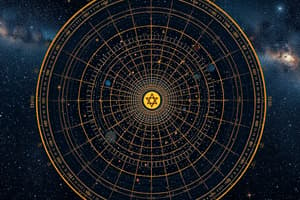Podcast
Questions and Answers
What is the spectral class of the Sun?
What is the spectral class of the Sun?
- F5
- K1
- G2 (correct)
- A7
Which star is classified as a supergiant?
Which star is classified as a supergiant?
- Arcturus (K2III)
- Vega (A0V)
- Betelgeuse (M2Ib) (correct)
- Sirius (A1V)
What is the point of entry to the main sequence called?
What is the point of entry to the main sequence called?
- Main sequence entry point (MSEP)
- Stellar evolution start (SES)
- Zero age main sequence (ZAMS) (correct)
- Main sequence inception (MSI)
How are star clusters' ages assessed in relation to their turnoff points?
How are star clusters' ages assessed in relation to their turnoff points?
What determines where in the main sequence a protostar enters?
What determines where in the main sequence a protostar enters?
What is the purpose of the Hertzsprung‐Russell (HR) diagram?
What is the purpose of the Hertzsprung‐Russell (HR) diagram?
What is the significance of the Hubble redshift in relation to the classification of stars?
What is the significance of the Hubble redshift in relation to the classification of stars?
What does the absolute magnitude of a star represent?
What does the absolute magnitude of a star represent?
How are stellar temperatures determined using filters?
How are stellar temperatures determined using filters?
What was the significance of adding the L and T classes to the classical Harvard sequence in 1999?
What was the significance of adding the L and T classes to the classical Harvard sequence in 1999?
Which star is an example of a bright giant?
Which star is an example of a bright giant?
What is the spectral class of Aldebaran?
What is the spectral class of Aldebaran?
Which star class spends most of its life as a main sequence star?
Which star class spends most of its life as a main sequence star?
What is the significance of the turnoff point in an HR diagram?
What is the significance of the turnoff point in an HR diagram?
Which stars become red giants after leaving the main sequence?
Which stars become red giants after leaving the main sequence?
What is the purpose of the Hertzsprung‐Russell (HR) diagram?
What is the purpose of the Hertzsprung‐Russell (HR) diagram?
How are stellar temperatures determined using filters?
How are stellar temperatures determined using filters?
What does the absolute magnitude of a star represent?
What does the absolute magnitude of a star represent?
What determines where in the main sequence a protostar enters?
What determines where in the main sequence a protostar enters?
What is the significance of the Hubble redshift in relation to the classification of stars?
What is the significance of the Hubble redshift in relation to the classification of stars?
Flashcards are hidden until you start studying
Study Notes
Star Classification
- The Sun's spectral class is G2V.
Stellar Evolution
- Supergiants are classified as large, luminous stars, such as Deneb.
- The point of entry to the main sequence is called the zero-age main sequence (ZAMS).
HR Diagram
- The Hertzsprung-Russell (HR) diagram plots a star's luminosity against its surface temperature, helping to classify stars and understand their evolution.
- The HR diagram's purpose is to understand stellar evolution and classify stars based on their luminosity and surface temperature.
Stellar Ages
- Star clusters' ages are assessed in relation to their turnoff points, which indicate the main-sequence lifetime of the cluster's most massive stars.
Protostar Entry
- A protostar's entry point into the main sequence is determined by its mass, with more massive stars entering the main sequence at higher temperatures.
Stellar Temperatures
- Stellar temperatures are determined using filters, which measure the star's color and brightness.
Harvard Sequence
- The addition of L and T classes to the classical Harvard sequence in 1999 extended the sequence to include cooler, lower-mass stars.
Star Examples
- Aldebaran is a K5III orange giant, with a spectral class of K5III.
- G-type main-sequence stars, like the Sun, spend most of their life as main-sequence stars.
Post-Main Sequence Evolution
- Low-mass stars become red giants after leaving the main sequence, while high-mass stars end their lives in a supernova explosion.
- The turnoff point in an HR diagram marks the end of the main-sequence lifetime for a star of a given mass.
Absolute Magnitude
- A star's absolute magnitude represents its intrinsic brightness, which is different from its apparent magnitude, which is affected by distance.
Studying That Suits You
Use AI to generate personalized quizzes and flashcards to suit your learning preferences.




